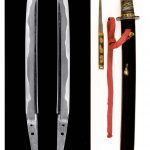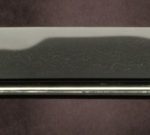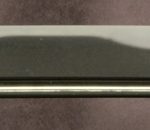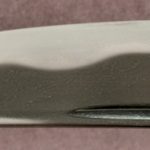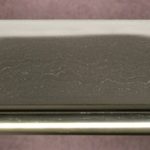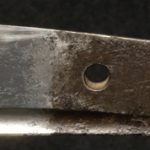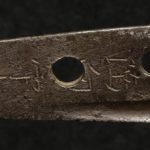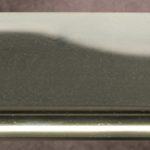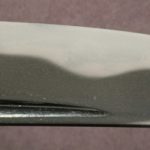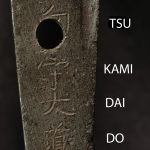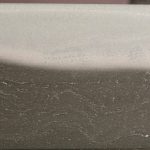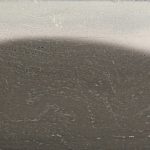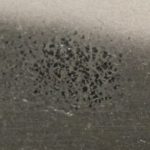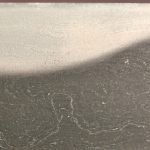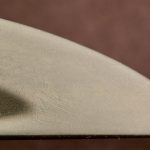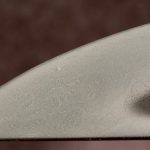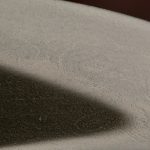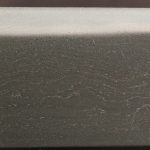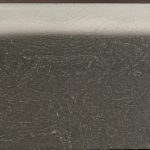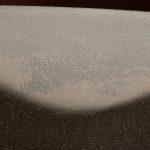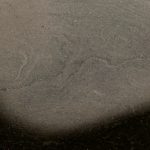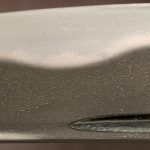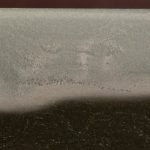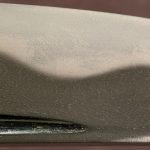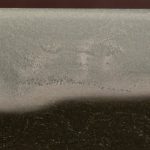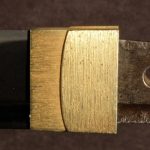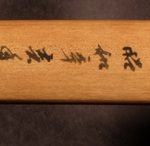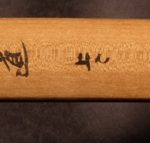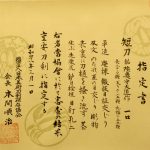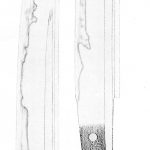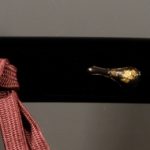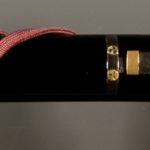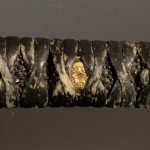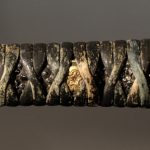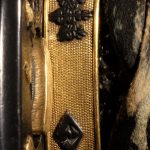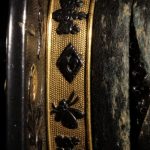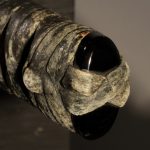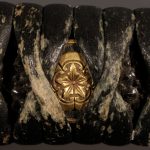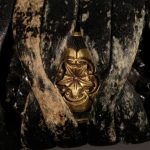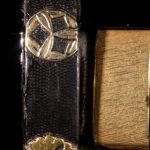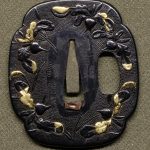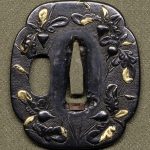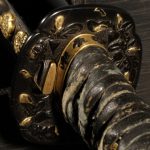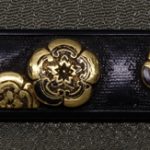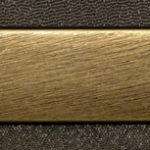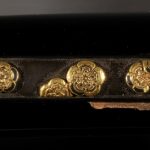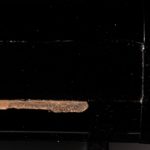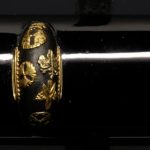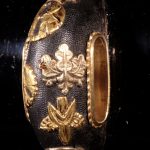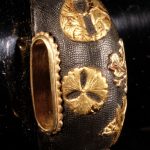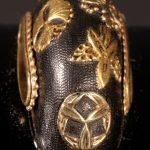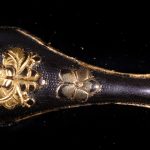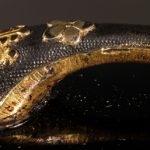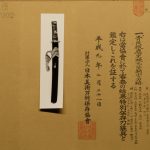DAIDO, MUTSU NO KAMI / NBTHK JUYO TOKEN
DAIDO
MUTSU no KAMI DAIDO SAKU
JUYO TOKEN
This is an exceptional blade and possibly the best extant Daido Tanto. As there are only 4-6 total Juyo Daido blades, by default, this is unquestionably one of the top 4-6 Daido blades in existence.
Daido’s name was originally Kanemichi. He forged a sword for the Emperor Ogimachi (1517-1593). The emperor was so impressed he presented Kanemichi the character from his name for Dai/O (大) or great. It was at this time that time he changed his name to Dai Kanemichi and later to Daido.
Daido essentially produced the Mishina school as his sons are Iga no Kami Kinmichi, Etchu
no Kami Masatoshi, Tanba no Kami Yoshimichi.
_____________________
Sayagaki, written by Dr. Homma and translates as follows:
Omote Side:
Mutsu [no] Kami Daido = Mei
Jojo
Hacho Kyu Sun Hachi Bu Han Kore Ari = A bit more than 9 sun 8 bu
Ura Side:
Showa Kannoto Idoshi Aki = Fall of 1971 (Date sayagaki was written)
Kunzan Shirusu with Kao = Written by Kunzan
______________________
The Juyo write-up below compares Daido’s work to Muramasa as he forged a symmetrical hamon bilaterally. See “explanation” below.
Juyo Translation:
Daidō
Jūyō-tōken at the 21st jūyō shinsa held on March 1, 1973
tantō, mei: Mutsu no Kami Daidō saku (陸奥守大道作) – “Made by Mutsu no Kami Daidō” Tōkyō, Ono Hiroshi (小野博)
Measurements
nagasa 30.0 cm, sori 0.25 cm, motohaba 2.55 cm, nakago-nagasa 9.0 cm, no nakago-sori Description
Keijō: hira-zukuri, iori-mune, wide mihaba, tending to sunnobi, little bit of sori
Kitae: itame that is mixed with masame, that features ji-nie, and that shows shirake
Hamon: notare in ko-nie-deki that is mixed with somewhat angular gunome elements, ashi, yō, hotsure, and sunagashi
Bōshi: midare-komi with a ko-maru-kaeri and hakikake
Horimono: on both sides a katana-hi that runs as kaki-nagashi into the tang
Nakago: ubu, kurijiri, higaki-yasurime, two mekugi-ana, the sashi-omote side bears centrally a naga-mei
Explanation
This is a work of Mutsu no Kami Daidō (陸奥守大道). Daidō was a Seki-based smith from Mino province from the end of the Muromachi period who also went by the name Kanemichi (兼道). Daidō focused on a notare and similar to Muramasa (村正) from Ise, he also hardened a hamon that is symmetrical on both sides of the blade. This tantō is such an example with a symmetrical hamon and is of an excellent deki.
______________________
This sword is published in Dr. Hommas Book, Kanto Hibi Sho, 1983, page 290.
Kanto Hibi Sho translation:
Daidō
Tantō, mei: Mutsu no Kami Daidō saku (陸奥守大道作) – “Made by Mutsu no Kami Daidō”
Nagasa 29.8 cm, two mekugi-ana, wide mihaba, iori-mune, relatively thins kasane, shallow sori. The kitae is a densely forged itame that is mixed with nagare and that features fine ji-nie. The hamon is a ō-notare in nie- deki that is mixed with ko-gunome, kinsuji, and many sunagashi. The bōshi features a wide ko-maru-kaeri, a nie-laden omote side with tendency to kaen, and hakikake and kinsuji on both sides. A katana-hi is engraved on both sides that runs as kaki-nagashi into the tang. This is a masterwork by this smith that looks at first glance like a Naoe-Shizu (直江志津) work. (Sayagaki written for polisher Ono Hiroshi [小野博], with the sentiment that he shall treasure it for a long time.)
________________________
From Markus Sesko’s, Swordsmiths of Japan:
DAIDŌ (大道), 1st gen., Tenshō (天正, 1573-1592), Mino – “Kanemichi” (兼道), “Ō-Kanemichi” (大兼道), “Minamoto Mutsu no Kami Daidō saku” (源陸奥守大道作), “Mutsu no Kami Daidō saku” (陸奥守大道作), Muroya- school (室屋), according to tradition the grandson of Daichi (大知), it is said that he first signed with Kanemichi (兼道) and that he worked in Seki, in the twelfth year of Eiroku (永禄, 1569), he made a blade for Emperor Ōgimachi (正親町, 1517-1593) whereupon he received from the emperor the character “Dai/Ō” (大) and the honorary title Mutsu no Kami, calling himself henceforth Ō-Kanemichi (大兼道, lit. “the Great Kanemichi”), Ō-Kanemichi eventually became Daidō (dō is the Sino-Japanese reading of the character michi), also the theory exists that Daidō was the same smith as Mishina Kanemichi (三品兼道) but this subject is not yet settled definitely, because of the similarities in workmanship of the two smiths it is also assumed that they were maybe brothers or father and son, “hybrid signatures” of the kind “Ō- Kanemichi” are found between the twelfth year of Eiroku (1569) and the first year of Tenshō (1573), he moved later to Gifu (岐阜), Daidō was one of the few outstanding masters of the Sue-Seki school, his works show quite a wide variety of interpretations, for example he also worked in the Bizen and the Yamato tradition, former works show a ko-itame mixed with mokume in combination with a chōji-midare with midare-utsuri, and the latter show a regular masame with a suguha and remind of the Hoshō school (保昌), works in Mino tradition show a gunome-midare with a tight nioiguchi that is mixed with tobiyaki, a Kenbō-midare, or a large dimensioned and more nie-laden gunome-midare that reminds of the Shizu school (志津), jō-saku.
Price: POR
If interested in owning this spectacular Tanto, contact me directly at: Yakiba.com@gmail.com
